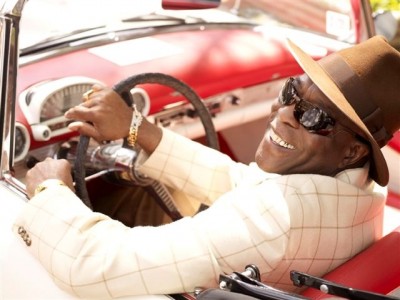
The former Chess Records guitar session man from Lettsworth, Louisiana, hardly requires an introduction. He is a superstar of the blues for his alluring electric guitar playing, with the Polka-dotted Strat and all. He played behind Muddy Waters, Willie Dixon, Howlinʼ Wolf, Little Walter, and Sonny Boy Williams. His legendary recording with Jr. Wells “Hoodoo Man Blues” is one of the all-time blues classics. He is an inductee in the Rock-and-Roll Hall of Fame and ranked in the Top 100 Greatest Guitarists of all time by Rolling Stone. Buddy Guy is an electric blues guitarist, a world famous blues-rocker who only rarely performs acoustically. Indeed, a case can be made that he is not really a true traditional blues or acoustic blues performer, but no traditional and country blues directory can be without paying homage to him for three simple reasons:
1. Muddy Waters, Folk Singer, Chess/MCA 1963.
The Chess brother, Leonard and Phil, wanted to cash in on the booming folk music wave of the early 1960s among white college students, who were avid LP record buyers. It dawned on them that they had a prime folk-singer in their own stable, which they took to be a financial pleasure. Muddy Waters had originally been “discovered” by
Alan Lomax and recorded at the Stovall Plantation in Mississippi in 1941. He was as folk as it gets, a deep roots bluesman. Letʼs give them some folk music, reasoned the record marketers, prompting Muddy to pull together an ensemble to record an acoustic album. Muddy picked bassist Willie Dixon and his guitarist Buddy Guy on acoustic guitar, even though the Chess brothers had instructed him to go down South and find “an old guy.” In 1993, Buddy Guy told the story to Blues Revue writer Gregory Isola, “When I walked in the studio, Leonard and them was cursinʼ at me. Muddy told them “Shut up!”. When I sit down and was playinʼ the shit with Muddy, they looked at me….”You didnʼt tell me you know that! You older than you say you are!” I say, “Well, thatʼs what I learned, man. I learned this ʻfore I did any damn thing else!” After all, Buddy Guy, son of a sharecropper, learned to play on an cheap Harmony guitar and used to fashion his own diddley bows as a kid in Louisiana. The resulting “Folk Singer” was a seminal album in the history of the folk and blues revival and was instrumental in turning thousands of people on to the acoustic blues. The timing of this release coincided with the burgeoning interest in the blues among new-found audiences in Europe and America, triggering many to explore the roots of the blues. “Folk Singer” was not the best acoustic blues album of all times, but it was one of the most important, a catalyst for a worldwide surge of the acoustic blues. Buddy Guy was a pivotal force in that.
2. Buddy Guy & Junior Wells, Alone and Acoustic, Alligator Records, 1981
Just when the world perceived these two musical partners were purely contemporary players, they surprised everybody with this acoustic gem. This masterful session recorded in Paris, France, between two friends, laid down on of the finest acoustic blues albums ever and once and for all times sealed the divide between the master and the disciples. Just about every acoustic and traditional blues musician who was internationally famous at the time had to tip their hats and take a bow to these two greats. Buddy Guy documented for all the world to see that not only could he play the acoustic blues, when he did he was the best. Simply beautiful. These players set the standard for acoustic blues with this album because they had the whole package– extraordinary skill, amazing musicality and the roots going way back to the origins of the blues. They played and all the other musicians listened and bowed, bare, simple, stripped down, heartfelt traditional blues as good as it gets. Many people, just about every record promoter and PR man will abuse the word “legendary” nowadays, but this duo well-deserved the title. By then they were blues-superstars and by making this exceptional record they again solidified the importance of the traditional music in the genre.
3. Buddy Guy, Blues Singer, Silvertone Records, 2003.
2003 was the official “Year of the blues” in the USA by an official act of congress and it was the 40th Anniversary of the seminal “Folk Singer” album with Muddy Waters. To celebrate and pay homage, Buddy Guy lined up a power ensemble to recreate the acoustic, traditional theme, this time with him as the leader. He called in some big shots: Jim Keltner on drums, Tony Garnier on upright bass, Eric Clapton and Jimbo Matthus on guitar. Buddy Guy played with true resolve and feeling, carrying a slow, easy groove. The session is gentle, with the session musicians supporting Buddy Guy in the most unobtrusive way. There is no noodling or showmanship, the tunes are bare, stripped and clean. “Blues Singer” is a direct continuation of “Folk Singer” in that a musician from the original session, now known predominately as a contemporary blues guitarist, reached back again to his musical roots to lay down an acoustic, traditional blues masterpiece.
Buddy Guy is the living legend who has kept the traditional blues close to his heart.
All we can say, while taking a bow, is “Maestro!”
